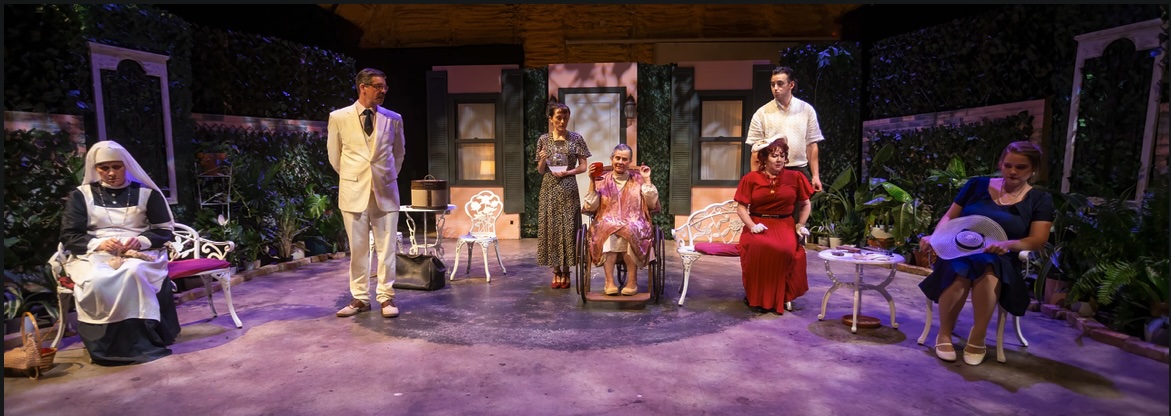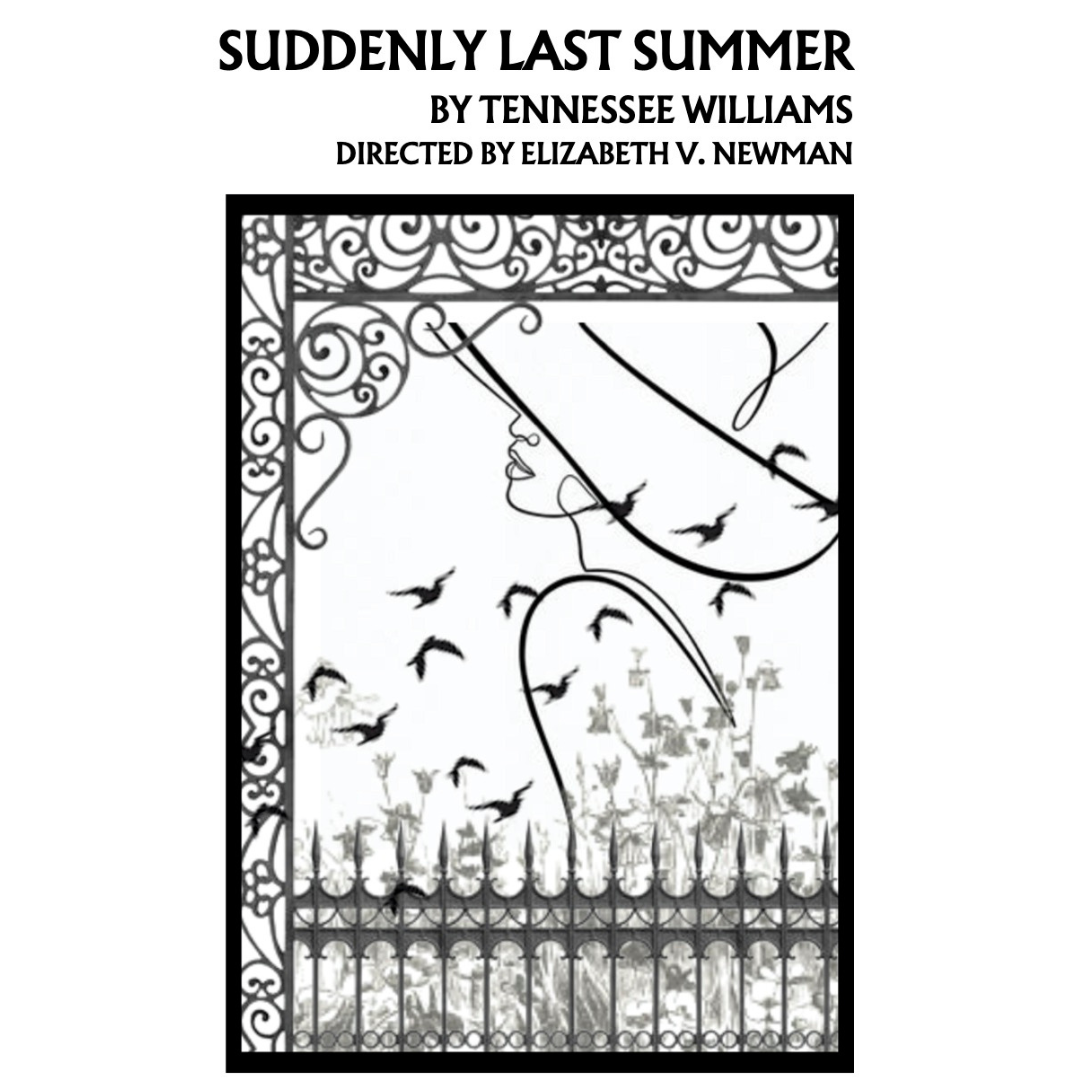Review: Suddenly Last Summer by Filigree Theatre
by David Glen Robinson
Tennessee Williams’ Suddenly Last Summer pries open the boiler door to reveal the flames of 1930s passion, mores, and the corruption of the thoroughly guilt-ridden ultra-wealthy in Great Depression New Orleans. The play isn't as well-known as Cat on a Hot Tin Roof or A Streetcar Named Desire, but in the hands of Elizabeth V. Newman and her excellent cast at Factory on Fifth in downtown east Austin, this weighty piece from the Willliams canon teaches us that there's enough shame to go all around. The 30s period touches, especially the costume design and antique wheelchair, give an almost seamless historic look to the play, deftly time-warping us moderns into Williams’ hypnotic, high chroma stories for a moral drubbing.
In a recent CTXLT interview, Elizabeth V. Newman told of her fascination with Williams: “I love the poetry and the imagery, and the characters are so richly drawn… and every time we talk about it, we gain more understanding, peeling back another layer of the onion of these complex, imperfect, but beautifully rich humans…in the world of…the poetry, the language, the musicality of his words both in the dialogue and even in the stage directions. That’s why Tennessee Williams, right there.”
_adj.jpg)
The huge talent and commitment of her cast draw out that bright but violent and oddly, effectively nuanced imagery to effect unrelenting maximum impact. That's why the piece is a one-act. There's no intermission to allow the audience to breathe. Hello, friends; you are inside the boiler.
The cast is comprised of Linda Nenno (Violet Venable, or Aunt Vi), Maddie Scanlan (Catherine Holly), Laura Ray (Sister Felicity), Shannon Grounds (Mrs. Holly), Chiara McCarty (Miss Foxhill), Max Hanesworth (George), Bryan Headrick (Doctor Cukrowicz, known as "Dr. Sugar"). Allison Paranka, Michael Morse, and Johanna Whitmore are understudies. Designers are Patrick Anthony (scenic and lighting design), Maddy Lamb (costume design), and Johann Mahler (sound design). Kit Brooks is stage manager. Dialect coach Kate Glasheen gave us that Southern Gothic vibe in dialect and intonation . Kudos to her and the cast, who never fell out of it.

A further special credit goes to the venue, Factory on Fifth, the emerging multimodal arts generator. It's one floating carrot in the east Austin pot roast of creativity. Newman and Filigree Theatre showed prescience in signing a contract to produce all their Season Six shows at the venue run by R.J. Armstrong and Kara Rozzi.
Williams's play qua play is a commanding piece of modernist writing. He builds slowly to a surprise with obvious anticipation and foreshadowing but no red herrings. The characters find no redemption, but there's culmination for almost all of them. In other words, there could be no story sequels for these characters. The repeated references to “Dr. Sugar’s” little black bag, ordinarily a symbol of healing, become as ominous as Chekhov’s firearm above the mantle, and the dictum is obeyed.
The story is set is the backyard garden of the Venable Mansion in the Garden District, an upper-class section of New Orleans. This is the “jungle garden" Violet Venable describes to Dr. Sugar in the opening scenes. White wrought-iron garden furniture is positioned around the space, and a smallish matching wrought-iron birdcage stands downstage right.
 The play of symbols starts immediately. That cage contains a Venus flytrap, the first hint of the character of Sebastian, Violet’s son. Sebastian, a poet, nurtured the predatory plant by feeding it flies bred for that purpose. Now that Sebastian is gone, Violet leaves the flytrap unfed, slowly dying, trapped in the birdcage just as she trapped Sebastian in life.
The play of symbols starts immediately. That cage contains a Venus flytrap, the first hint of the character of Sebastian, Violet’s son. Sebastian, a poet, nurtured the predatory plant by feeding it flies bred for that purpose. Now that Sebastian is gone, Violet leaves the flytrap unfed, slowly dying, trapped in the birdcage just as she trapped Sebastian in life.
Linda Nenno as Violet sets in place the premises of the play with multiple stories about her summer travels with her poet son. He wrote his single annual poem at that season. Vi’s apocalyptic story of their ocean voyage to the Galapagos Islands is especially lengthy; she dwells upon Sebastian’s fascination with the seabirds preying on new-hatched baby sea turtles struggling toward life in the sea. She vividly depicts the darkness of the sky, the evil birds, and the volcanic rocks and sand upon which new life struggled and died.
Vi claims Sebastian was trying to find God. Dr. Sugar, a psychiatrist and surgeon who has pioneered lobotomy surgery, is not convinced.
When Violet could not travel with Sebastian last summer, he chose his cousin Catherine to accompany him abroad. He did not write a poem that summer. At the Spanish resort Cabeza de Lobo (Wolf's Head in English), Sebastian died under mysterious circumstances. Lobo rhymes with loco; cousin Catherine has been confined to a mental asylum since her return, allowed out for short visits only when accompanied by a nurse. The curve of drama steepens considerably when Violet offers to build a new wing in Dr. Sugar’s hospital if he will lobotomize Catherine and “cut that story out of her head.”
Now who’s the predatory Venus flytrap, Vi? Here are symbols and meta symbols.
Violet absents herself to mix five o’clock frozen daiquiri. Things are still quakingly tense.
_adj.jpg)
Catherine enters the jungle garden with Sister Felicity, her nurse. Maddie Scanlan reveals Catherine's character as much by showing as by telling, particularly with symbolic points involvng cigarettes and her fascination with them. She wounds Sister Felicity (Laura Ray) with one smoke; she puts out another in Aunt Vi’s empty red daiquiri glass. Scanlan reveals Catherine’s passive-aggressive core, contradicting her declarations that she couldn’t possibly hate anyone. She's both mentally disturbed and cynical, no contradiction. Catherine's outright abuse of Sister Felicity while claiming the opposite was an ironic nugget, a tribute to Williams’s mature brilliance as a playwright.
_adj.jpg) Shannon Grounds as Mrs. Holly and Max Hanesworth as her son George enter together and almost steal the show. They're Catherine's mother and brother, and they prove that the dominant fragrance in the flowery Garden District is the scent of money. They give us a series of absolutely delicious awkward silences superbly directed by Newman and perfectly delivered by the actors. At last, it comes out that they stand to inherit much from Sebastian’s estate—provided Catherine drops her story of Sebastian’s demise or accepts lobotomy.
Shannon Grounds as Mrs. Holly and Max Hanesworth as her son George enter together and almost steal the show. They're Catherine's mother and brother, and they prove that the dominant fragrance in the flowery Garden District is the scent of money. They give us a series of absolutely delicious awkward silences superbly directed by Newman and perfectly delivered by the actors. At last, it comes out that they stand to inherit much from Sebastian’s estate—provided Catherine drops her story of Sebastian’s demise or accepts lobotomy.
So much for filial love and family solidarity.
The 1930s was the era of electro-shock treatment, lobotomy, and truth serum. Catherine has already had electro-shock, and we witness Dr. Sugar's administration of truth serum and use of hypnotherapy. Bryan Headrick's application of the technique appears authentic to a non-medical layman. Scanlan’s enactment of Catherine’s banned story leads to the end of the play. Her performance is a tribute to Scanlan’s talent and skill, as well as to the company's interpretation of Tennessee Williams’ writing.
_adj.jpg)
Cabeza de Lobo is so much more than a beach. It's the garden out back, the Galapagos, the spider web of relations, the hunting ground of Sebastian’s need for flesh. Violet wants all of that excised to save Sebastian’s reputation. Those naked children on the beach, referenced several times, couldn’t be written into a play even once today, but Williams brings them forth in vivid imagery. Initially, they clearly symbolized the turtle hatchlings struggling across the Galapagos beach. They then vampired into predatory birds feeding on innocent flesh. This was exposed in Scanlan’s creation of Catherine's clear, dramatically emotional, and yet dreamy exposition under drug-induced hypnosis.
That combination of elements doesn’t quite wash but was probably a stage theatrical necessity. Kudos to Scanlan.
Williams’s sister Rose was lobotomized and confined to a mental institution in New York State for decades. She outlived Williams by several years (see? Wikipedia is good for a few things). Williams provided generously for her care in his last will and testament. Connecting the dots from this to Suddenly, Last Summer is tempting. It seems to this reviewer that Williams, whose work is filled with confessions of guilt and expressions of shame, might have believed it would be better to allow a highly structured but fractious family to collapse and dissipate rather than to denature even a single human life capable of loving and turning toward the light.
Speculation aside, what we are given on the page and on the stage helps us understand the psychic violence families can do to each other in various Cabezas de Lobo of the mind. Newman and Filigree Theatre have produced an admirable work, for which the community is grateful. The play is recommended for all.
If you're one of those who attend stage plays about once a year, this one should be your 2024 choice.
Suddenly Last Summer runs until October 20, 2024 at Factory on Fifth, 3409 E. 5th St. in downtown east Austin.
EXTRAS
Click to view the Filigree Theatre program for Suddenly Last Summer.
Video Promo - Photos by Steve Rogers
Suddenly Last Summer
by Tennessee Williams
Filigree Theatre
October 04 - October 20, 2024
October 4 - 20, 2024
Thursdays - Sundays
Factory on Fifth, Austin
|
